New Delhi: Literature lovers, writers and researchers carefully turned the stained pages of 18th-century Mughal poet Mir Taqi Mir’s rare manuscripts, handwritten with black ink. The week-long exhibition in Anjuman Taraqqi Urdu Hind recently showcased the poet’s work, kept safe over the years in different parts of the world including Pakistan, Iran, and Malaysia.
Through relentless research and hard work, Anjuman Taraqqi Urdu Hind, popularly known as Urdu Ghar—a non-profit organisation that promotes Urdu language, literature, and culture—managed to bring home the rarest text including his Masnavi, Dariya-e-Ishq, Diwan-e-Haftum, Kulliyat-e-Mir. There was even a collection of stories that Mir had written for his son, along with some of his unpublished work translated from Persian to Urdu by Sadaf Fatima, a research scholar working with the organisation.
The exhibition was done in collaboration with Noor International Microfilm Centre, a research institute that preserves and restores historical documents, and Iran Culture House.
“Mir had completely been sidelined but you cannot work in Delhi and not work on a prominent 18th-century poet like him. So we decided to bring people’s attention to Mir through initiatives like this one,” said Fatima in a conversation with ThePrint.
The audience was treated to a guided tour, giving them an unprecedented glimpse into the life and literary legacy of Mir. The takeaway was that Mir as a poet cannot be “ignored”.
“Mir’s writings, especially Zikr-e-Mir, his autobiography, show you the history of Delhi and Lucknow. You get to know about the situation, how the politics are changing, how the scenario is changing,” said Fatima.
Also read:
Understanding Mir
Among the highlights is the Nuskha-e-Rampur, an 1826 manuscript encompassing a complete collection of Mir’s poetry and prose from Rampur, Uttar Pradesh compiled in two volumes. Another attraction is the uncensored 1816 version of Zikr-e-Mir. “This text predates the censored versions that were later published,” Fatima said, emphasising its rarity and importance for researchers.
The exhibit also includes the Nuskha-e-Itawa, a rare book first published in 1928 by Maulvi Abdul Haq, Anjuman’s inaugural General Secretary. This manuscript was housed at the Azad Library in Aligarh Muslim University, before being reclaimed by Anjuman recently.
An unnamed manuscript of poetry from Fort William College, an academy of oriental studies in Kolkata, was also on display. The college is where Mir’s poetry collection was first published posthumously in 1811. “This is the original complete work, edited and prepared under Mir’s guidance but published a year after his death,” Fatima told ThePrint. This manuscript has served as the basis for most contemporary editions of Mir’s work.
A significant discovery on display is Mir’s seventh poetry collection. Fatima said that scholars are currently researching whether this could be a new addition to Mir’s collections or a compilation of his earlier works.
Also featured are the Masnavi Darya-e-Ishq, an 1833 manuscript exemplifying Mir’s narrative poetry based on themes of love and passion, and the Persian manuscript of Nuskha-e-Adabiyat, acquired from Hyderabad by the Iran Culture House. “Mir’s writings in Farsi [Persian] were fewer compared to Urdu, making this a valuable part of the collection,” Fatima said.
Urdu Ghar is making the manuscripts available on its official website for anyone interested in studying Mir’s work.
Muiz Qureshi, a former historian travelled to the exhibition from Moradabad after he read about it on Facebook. “I feel proud to be surrounded by these rare manuscripts. He was an iconic legend of his times,” said Qureshi.
Another visitor, Umer Abbas, a PhD student in English literature, said that Mir’s work defined “Urdu Adab” and Urdu poetry would be incomplete without it. Quoting famous Urdu poet Jaun Elia’s couplet from Darakht-e-Zard about Mir, Abbas said: “Hamara Ghalib-e-azam tha chor aqa-e-bedil ka, so rizq-e-faḳhr ab ham kha rahe hain Mir-e-bismil ka (Our Ghalib was supreme, leave aside the master of Bedil, Now we are consuming the sustenance of Mir, the wounded).”
(Edited by Theres Sudeep)







Ms. Bakhsh is too clever by half.
While writing for The Print, she phrases things in such a manner that no one has a clear idea of what her personal points of view and political inclinations are.
However, while writing for other platforms such as Coda, the Islamist inside her comes through. She always refers to Kashmir as “Indian administered Kashmir which is claimed by Pakistan”. Also, the tone and tenor of her articles clearly indicate that she does not consider herself to be an Indian. Rather she presents herself as a prisoner of India coerced to stay in India.
Her duplicity and pretentiousness is startling indeed. Under the guise of a secular-liberal person lies a hardened Islamist.
That’s the funny thing. Kashmiris always get excited about Urdu literature and poetry. However, Urdu-speaking people (e.g. Mohajirs if Pakistan) don’t feel the same way for the Kashmiri language. Usually they look down on Kashmiri and mock it’s literature. In fact, in “Azad” Kashmir (Pakistan occupied Kashmir), an overwhelming majority of the Kashmiri people cannot read or write Kashmiri. Urdu is their first language.
Urdu is a grossly overrated language. Maybe because the Hindi-belt carries an inferiority complex vis-a-vis Urdu.
The liberal secular cabal has quite consciously championed the cause of Urdu while systematically undermining Hindi. Over decades, this has damaged the psyche of the Hindi speaking heartland of India gradually creating an inferiority complex in them.
This is shameful to say the least.
Here in Assam, we laugh at people who think Urdu is a language worth celebrating. Urdu literature and poetry is far inferior compared to Assamese, Bengali, Marathi and south Indian languages.